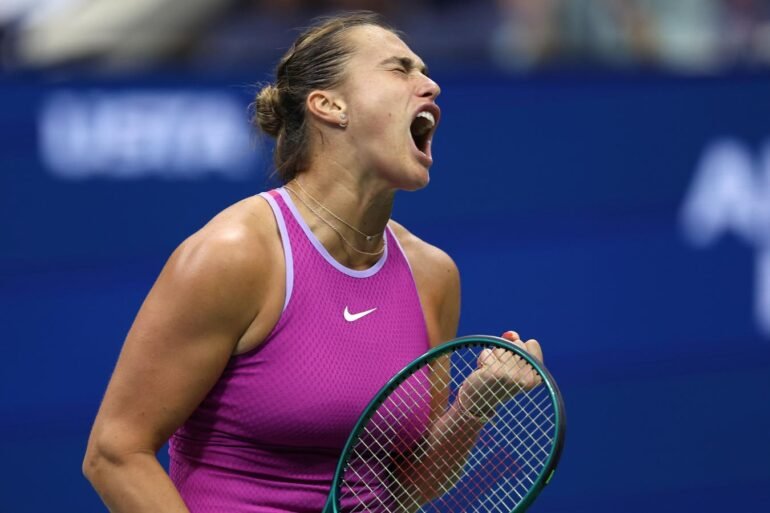NEW YORK, NEW YORK – SEPTEMBER 07: Aryna Sabalenka of Belarus reacts against Jessica Pegula of the United States during their Women’s Singles Final match on Day Thirteen of the 2024 US Open at USTA Billie Jean King National Tennis Center on September 07, 2024 in the Flushing neighborhood of the Queens borough of New York City. (Photo by Al Bello/Getty Images)
Getty Images
Feel The Fear And Do It Anyway, the original self-help book of the 80s, had a section called the No-Lose Model. At face value, that might be a difficult concept to sell to the combatants in the U.S. Open women’s singles final on Saturday. World No.1 Aryna Sabalenka takes on home girl Amanda Anisimova in what has all the makings of a gut-churning classic. Both players want the win so bad it hurts. This could be popcorn viewing with a bittersweet crunch.
Sabalenka has endured a traumatic time at the business end of the 2025 majors, losing the Australian Open endgame to Madison Keys and coming up short in an error-strewn Roland Garros showpiece against Coco Gauff. She also lost in three sets to Anisimova at the Wimbledon semifinal stage. Those six months of slam agony suck.
The 27-year-old must pine for a perfect Iga Swiatek-like final record rather than the 3-3 ratio that hints at an increasing vulnerability on prizegiving day. Nevertheless, this is the Belarusian’s sixth consecutive Grand Slam hard court final. She is the defending champion too, beating Jessica Pegula in 2024 and then again in Thursday’s semifinal after ceding the first set. Pegula said her opponent “plays really fearless.” It’s not always the way.
Sabalenka has admitted to self-doubt during their clash at the All England Club in July. “”I felt like in that match at Wimby, I was doubting a lot my decisions, and that was the main thing that was bringing a lot of unforced errors,” she said ahead of the rematch. Anisimova has fully committed to her shots in New York and if that brings the same rewards for her – and similar issues for Sabalenka – then things could get very stressful for the latter in front of a more partisan crowd.
Anisimova’s story in 2025 has really gathered pace since February, when she won the WTA 1000 Qatar Open in Doha. Switching surfaces, she reached the Queen’s Club final in West London, only losing out to the bewitching grass court guile of Tatjana Maria. The eighth seed followed up with a brilliant Wimbledon journey that went all the way before ending in an hour of frightening double bagel turbulence against Swiatek.
“I know I didn’t have enough today, but I’m going to keep putting in the work. And I always believe in myself, so I hope to be back here one day,” said the 24-year-old afterwards. She froze, but she rose to get back on the horse immediately for another shot.
The omens on the stats board are good. Anisimova holds a 6-3 record over the favorite. An exasperated Sabalenka was quick to blow up in the press conference after the Centre Court defeat, claiming her opponent should have apologized for celebrating a winner too early. Anisimova had already been in the umpire’s ear about the constant shouting across the other side of the net. If SW19 was feisty, wait until the home ZIP code comes into it.
Anisimova will be in Sabalenka’s head for all kinds of reasons before they even hit a ball. The American’s game matches up well on hard courts, including a comprehensive win in Toronto over the three-time slam champion in 2024. The former 2017 junior U.S. Open champion hit a colossal 50 winners in her thrilling semifinal victory over Naomi Osaka.
Sabalenka has the power, but Anisimova’s key metrics were well ahead of the pack coming into the quarterfinal against Swiatek. Her average backhand speed at this U.S. Open is faster than that of Jannik Sinner and Carlos Alcaraz. “She moved better and she played better,” according to the Wimbledon champion, who was limited to just seven games.
An unfettered Anisimova hitting off either wing is going to be a problem for anyone. Both will go big. Sabalenka is often held captive by her emotions when big matches go wrong. She has promised there will be no repeat of her unsporting press conference at the French Open final, but the prospect of losing three major finals in a year could play a huge factor if things get tight.
Anisimova had a sense of mission against Swiatek, creating a sea of calm that transcended the ups and downs of the match. She was understandably more on edge against Osaka as the finale approached. The attitude is still prone to a “mope” as Martina Navratilova observed. Mindset techniques and painting have helped center her after taking a break from the game for mental health reasons in 2023.
NEW YORK, NEW YORK – SEPTEMBER 04: Amanda Anisimova of the United States reacts to defeating Naomi Osaka of Japan in the semi-final on Day 12 of the US Open at USTA Billie Jean King National Tennis Center on September 04, 2025 in New York City (Photo by Robert Prange/Getty Images)
Getty Images
If Anisimova can manage the brush strokes on court and deploy the heavy-duty ammunition accurately on Saturday, then the match will go all the way. In Feel The Fear, the author mentions the Chinese proverb behind the No-Lose theory: “If we do not change our direction, we are likely to end up where we are headed.”
Whoever is brave enough to stay the course, or change it before it’s too late, will pick up the trophy. Sabalenka needs it to save her major season. Anisimova has dreamt of being in the final at Flushing Meadows “forever.” The stakes are high and the stress will be palpable.

